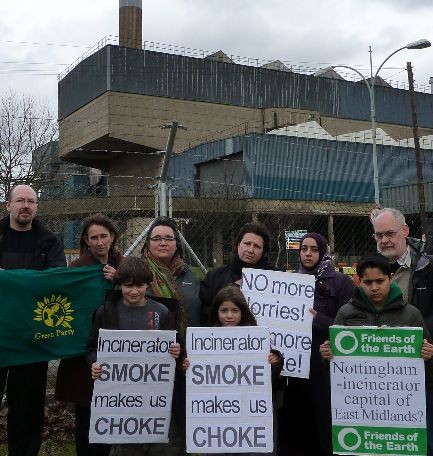The Environment Agency is consulting on plans to permit a 25% increase in annual pollution from the Eastcroft Incinerator. The Agency has dismissed arguments from local residents that 'best available technology' should be able to reduce permitted emissions.
Incinerator operator WRG wants to increase waste throughput in the existing two furnaces from 160,000 tonnes per year to 200,000 tonnes. The Agency has agreed, without any reduction in pollution permitted in the exhaust gases. Much of the additional tonnage will be commercial and industrial waste imported from around the region.

|
The Agency accepts that incinerators emit persistent organic pollutants (POPs) such as dioxins, and that regulations therefore require 'priority consideration to alternative processes, techniques or practices ...' But no consideration has been given to alternative processes to incineration for the additional 40,000 tpa, only to ways of controlling incinerators. Indeed one of the legal requirements for controlling incinerators is that combustion gases are resident for at least 2 seconds at 850degC - a condition which the two existing furnaces do not meet. But the Agency notes they have a 'derogation' so there is no requirement to even consider applying stricter rules!
We say that most of the waste to be burnt in the incinerator could and should be separated for reuse, recycling or composting. That should be done close to where waste is produced and not imported to Nottingham for burning. Therefore the appropriate alternative is to not burn more waste.
The Agency is also not very interested in how inefficient the incinerator and associated district heating system is. We have previously shown that the incinerator is only 33% efficient.
In terms of ball-game figures, each year the incinerator currently burns upto 160,000 tonnes waste. It emits around 150,000 tonnes CO2. Around 60 GWh electricity is sold to the grid and around 90 GWh heat is sold to district heating customers. Even if two thirds of the CO2 is ignored (because it doesn't come from fossil carbon), that works out at 330 grammes CO2 per kWh. This compares to 200g CO2 per kWh for gas central heating and 500g per kWh for grid electricity. The Committee on Climate Change says that carbon intensity of the grid should be reduced to around 50g CO2 per kWh by 2030. In other words, the incinerator is just as carbon intensive as fossil fuels and cannot be part of a low carbon future.
The Agency is now consulting on this proposal to 14 June 2012 - details on their website. You can tell the Agency what you think:
- Is the incinerator 'best available technology'?
- Should they have considered alternatives to incineration for avoiding POPs?
- Is it acceptable to import commercial and industrial waste from around the region?
- Can the incinerator be described as low carbon?
The issue was discussed on BBC East Midlands Today on 17 May 2012.
As well as the proposed expansion to 200,000tpa, work is already underway to add a third line to take capacity to 300,000tpa. To make this possible, WRG also intends to ask for planning permission to allow articulated lorries to bring waste from transfer stations around the region. (See our previous article - Jan 2011.)
